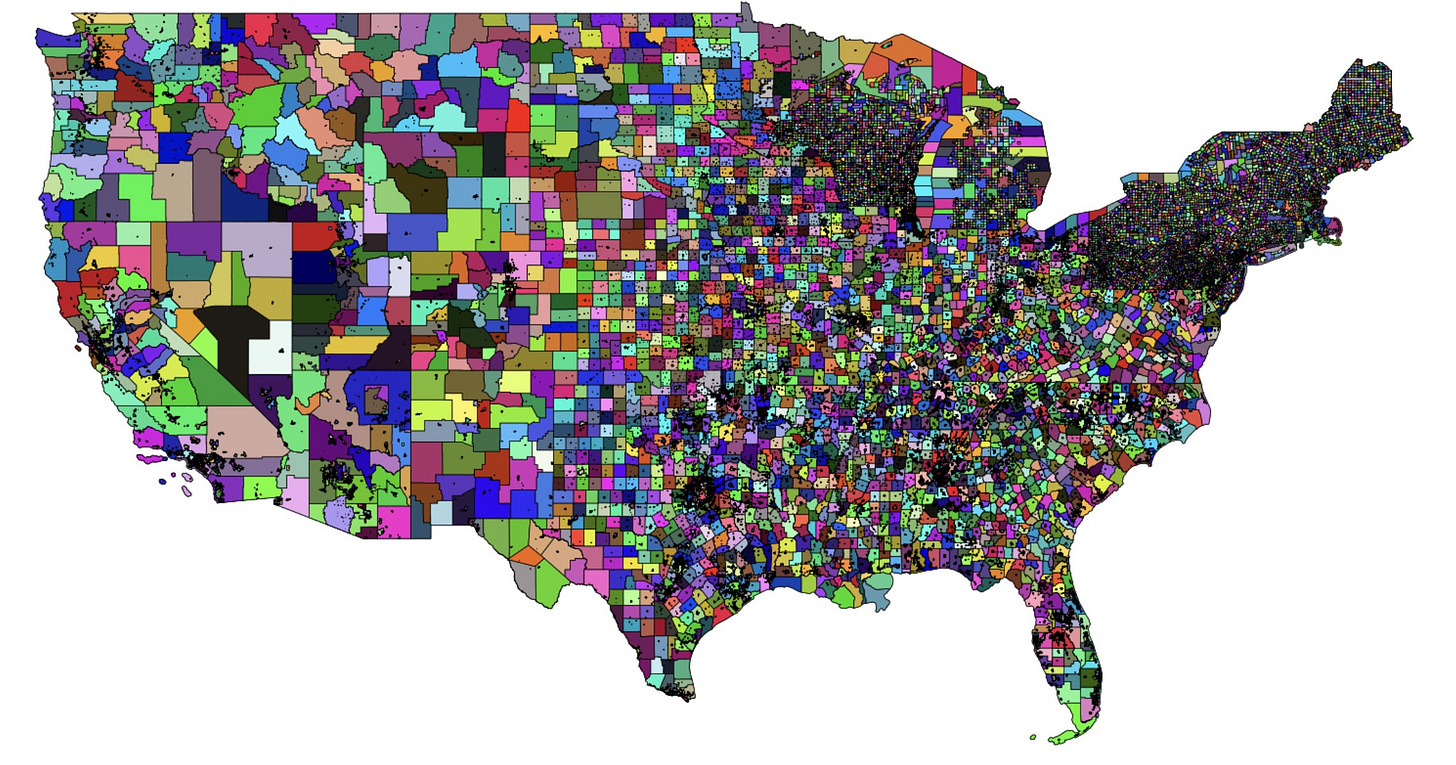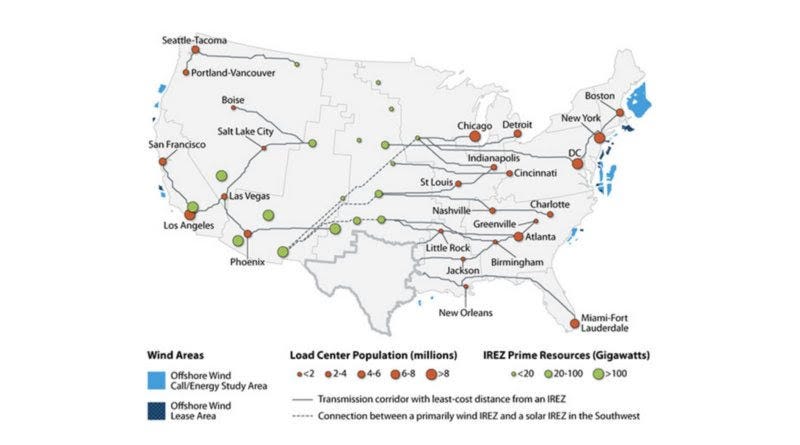The Reality of "No Transition Without Transmission"
Steamrolling local communities will backfire
Sometimes I rip long threads on Twitter instead of writing a full blog post on Grand Prismatic so I will start copying them to substack even if the content feels choppy. The point of this thread is very related to an imminent blog post that takes the below idea further.
The bottom image shows a transmission expansion plan to bring cheap energy from high-potential renewable zones to population centers
The top image shows all the local jurisdictions standing in its way, each with a unique zoning code and economic development mandate from the community it represents
But based on what I've seen in local ordinances, I’m concerned that projects primarily designed to export power across the country have particularly high permitting risk.
Ordinances commonly group new gen projects into tiers (1-4) or designations (accessory vs. primary use) based on the type of project, where higher tiers usually have more onerous restrictions (fewer allowed zoning districts, larger setbacks, lengthier permitting processes, etc.)
However, many of the demarcations between tiers are based on how the power is used + the quantity exported to the grid, not the total size of the project in kW or acreage
A common rule outlines tiers by the % of power a project exports off-site
For example, if a proposed system exports more than 200% of the annual on-prem consumption, it gets bumped into a higher permitting tier, often requiring a presentation to the planning board and having a full hearing with community members
The latter scenario drastically increases the surface area of resistance, costing more time & resources to develop the project + boosting risk of failure
Why do BTM systems have fewer permitting restrictions? It could be only that they tend to be smaller...
But if this were the case, why not just make restrictions based on acreage or kW production limits, not how the energy is used? I'd argue communities make a deliberate effort to prioritize energy infrastructure that supports the local economy
Wind and solar are famously zero marginal cost resources, which means they create few long-lasting jobs for local residents – unless that electricity is consumed onsite or immediately nearby for some industrial or commercial use case
Most proposed projects + proposed policies (like the one that produced the screenshot above) are understandably oriented around lowering the aggregate costs of producing energy
But this is a tough sell for host communities when all the power is pumped to load centers (or the “coastal elites”) and the projects add nothing to the local economy but tax revenues
And even then, developers understandably seek substantial tax breaks, alienating residents, which this local news article sums up nicely: https://nysfocus.com/2023/11/07/tax-breaks-wind-solar-new-york
This is a fundamentally extractive approach to capturing these high-potential resources
You’re taking the cheap raw materials and letting all the lucrative downstream economic activity materialize elsewhere
Steamrolling local jurisdictions by further centralizing permitting processes carries its own risks
Programs like ORES in NY and CPCN in MD that bypass local permitting processes and go straight to the state provide more certainty for project developers, but they are more technical, expensive, and time-consuming, and do not exactly temper the narrative of elite interests seizing control from small communities
Plus, if every 5-10 MW solar project has to go through the same state agency then they might get just as overwhelmed as interconnection queues
It’s been clear to me for a while that interconnection costs + the queue crisis are forcing functions for co-location but I think permitting issues will / are producing just as much of a tailwind
People laughed the last time I wrote about greenfield manufacturing (“just move the cities to where the renewables are!!”)
If you think about how deeply the Industrial Revolution reshaped society and redistributed global populations, and what will be required to fully execute the current energy transition, then I don’t think it is as unrealistic as it seems
But it will require reinvigorating and empowering, not bypassing, local governments – namely, the townships, munis, and counties that control zoning, permitting, tax breaks, and economic development within their jurisdictions




I hear you about the reality of local resentment of "extractive" generation and transmission. What I don't fully understand yet is why RE in particular triggers that kind of autarkic, zero-sum thinking. Normally when an area has a unique and valuable resource that it sells to people further afield, we think of it as an opportunity: National Parks sell tourism, particular climates + soils sell agricultural products, natural ports and rivers sell transportation services. Why is a solar panel extractive while a corn field or a cool rock is a point of pride?
I saw a paper* look at why farmers in Scotland preferred to plant food crops even when bioenergy crops came with financial incentives, and their survey evidence pointed to the socio-cultural role of "feeding people" as providing more emotional value than "fueling a power plant". Our cultural veneration of farmers has built an identity and a social-cultural role that gives people a deep sense of meaning that a solar panel obviously does not (yet!). My current guess is the "emotional wages" of RE are the primary barrier, rather than any financial/technical consideration. Maybe we need to say "thank you for your service" and give priority airline boarding to people leasing land to wind turbines 😂
* the paper: https://www.sciencedirect.com/science/article/abs/pii/S0743016716300523